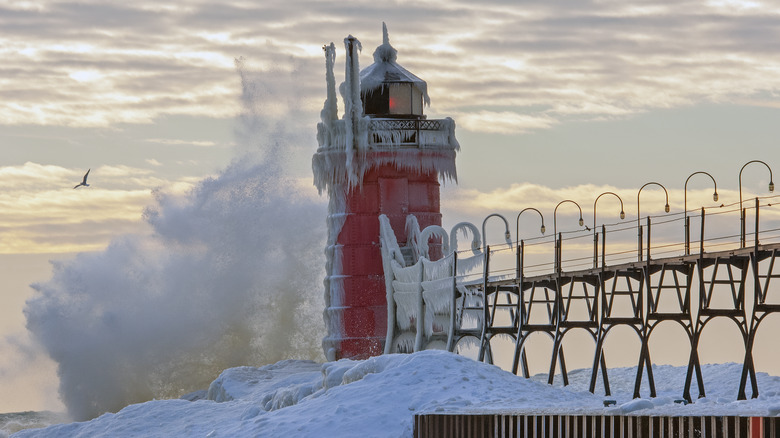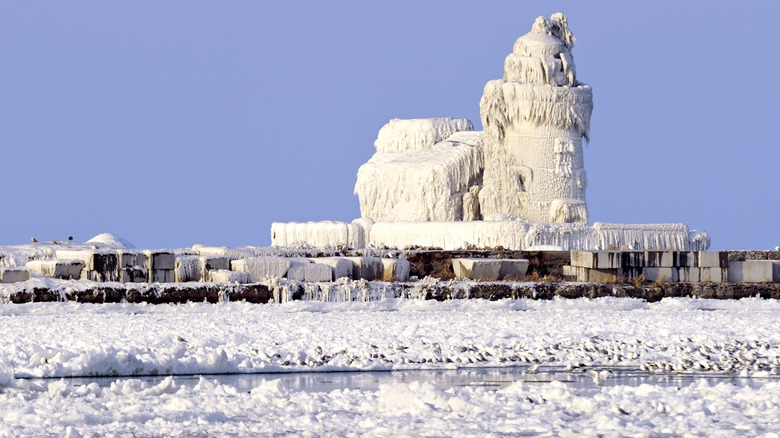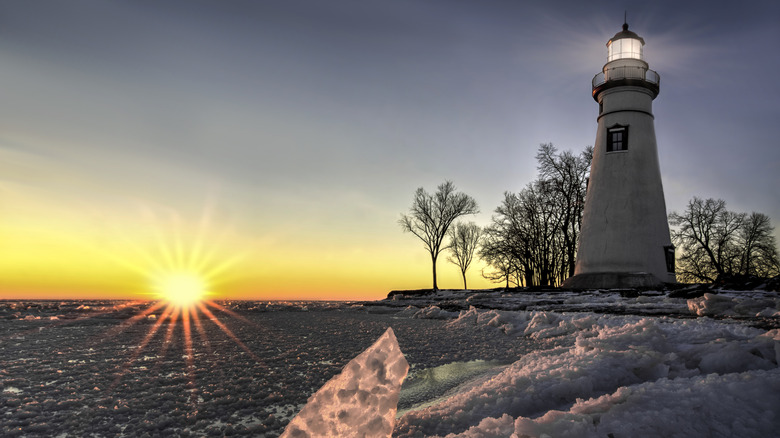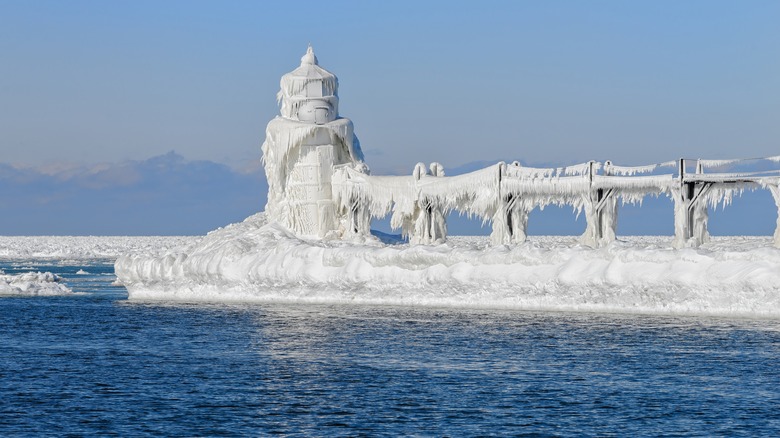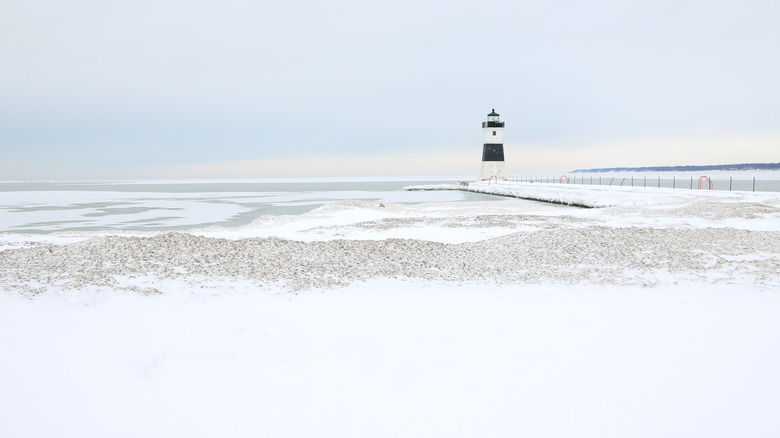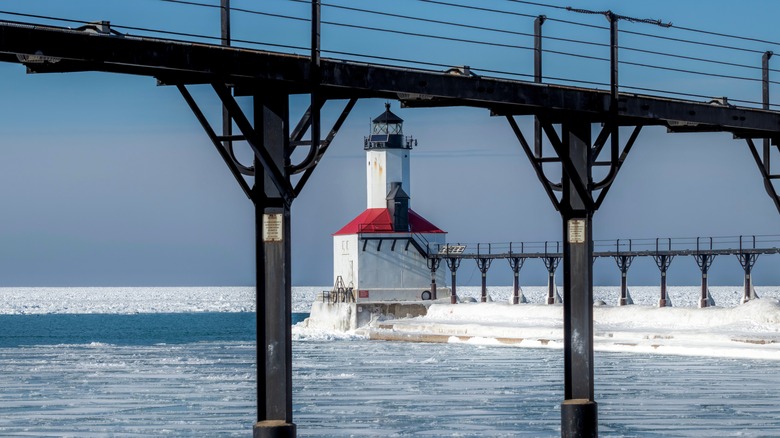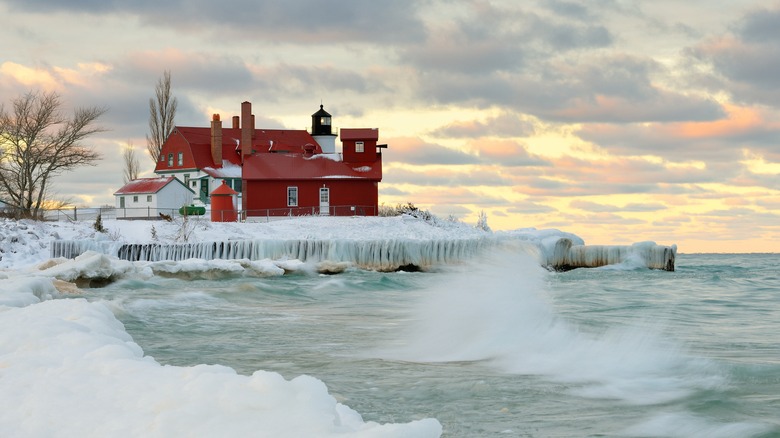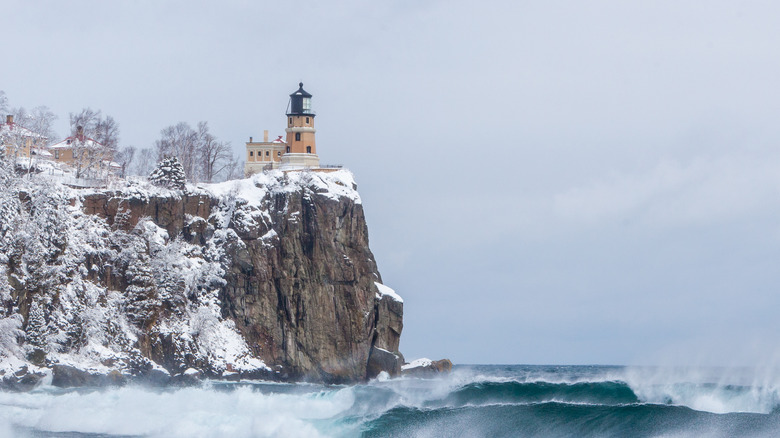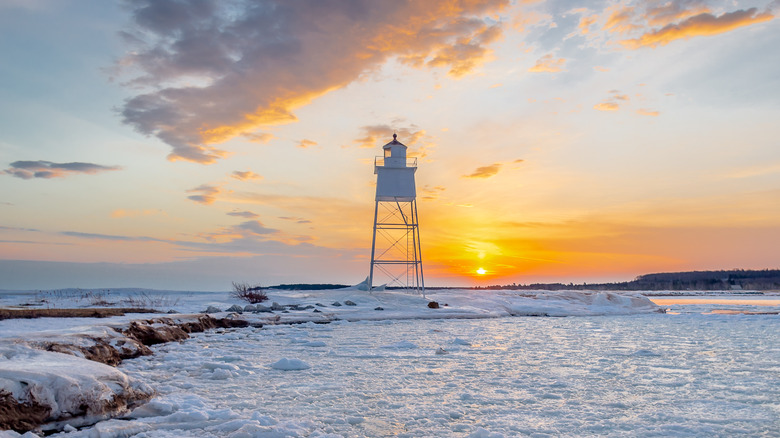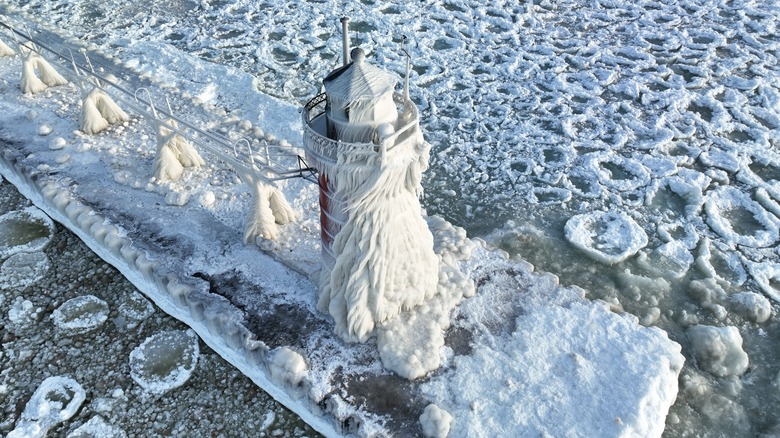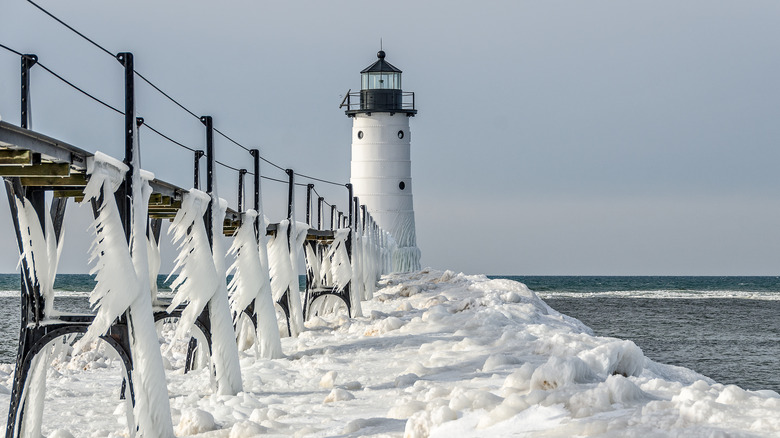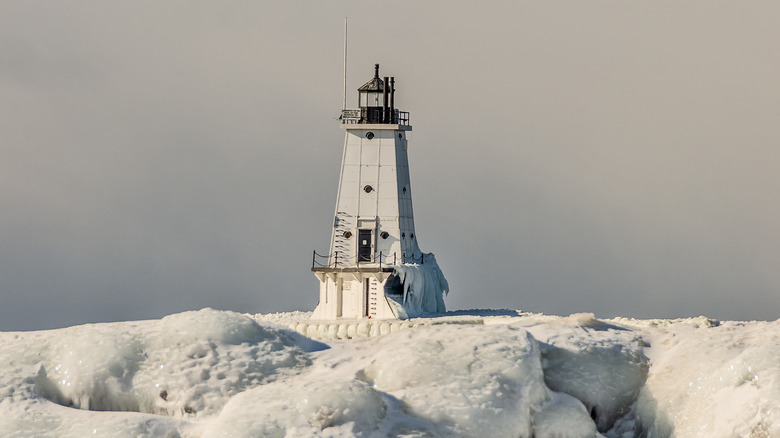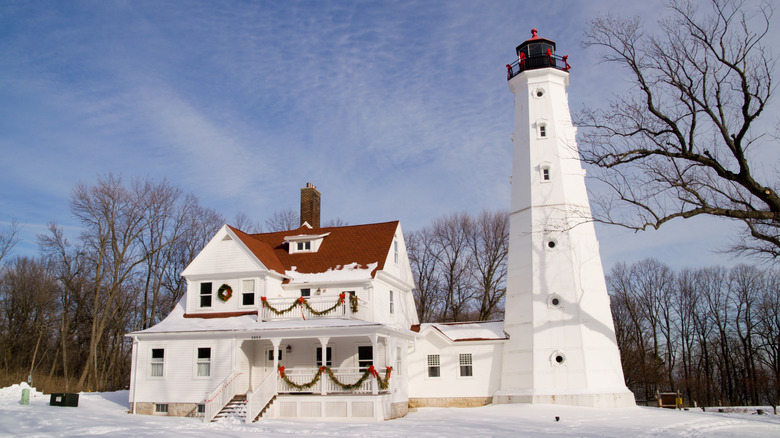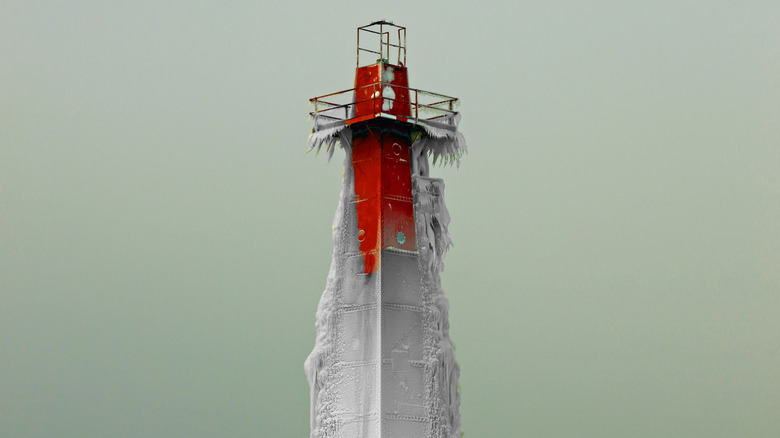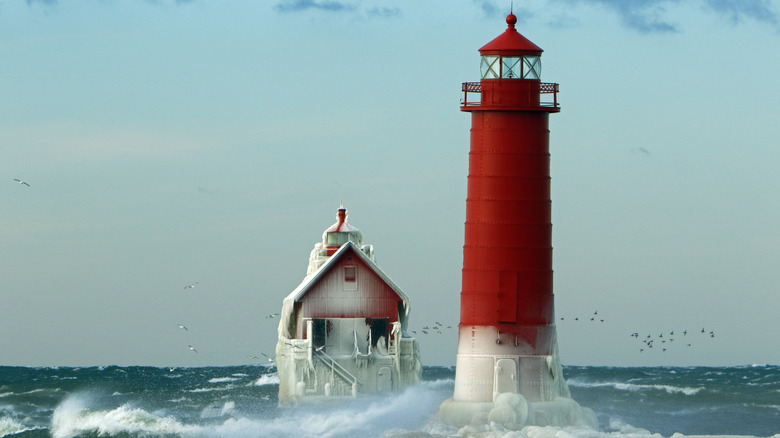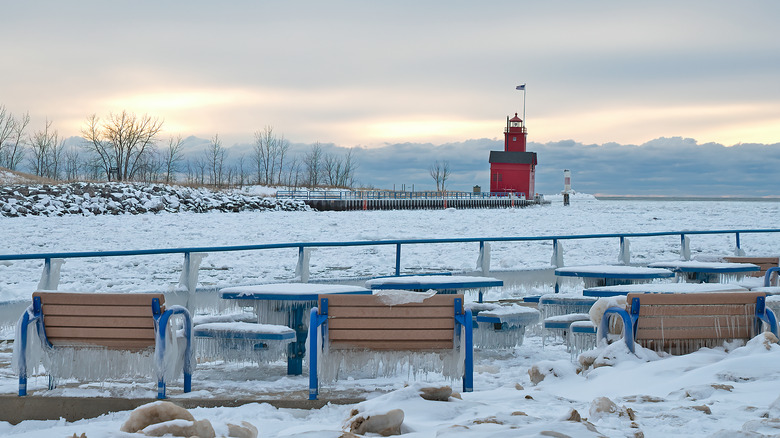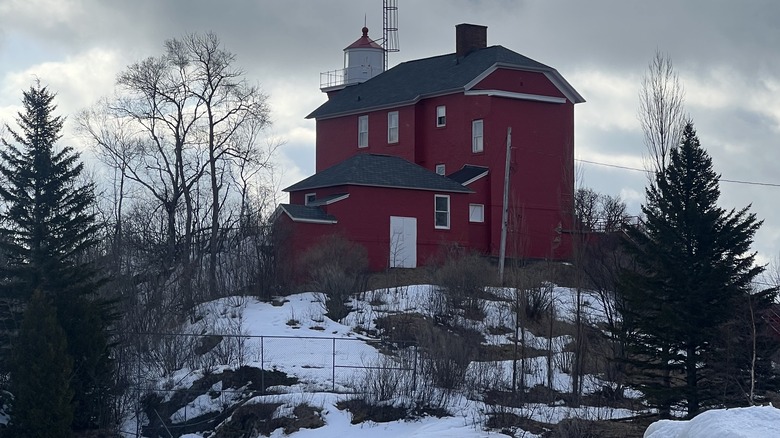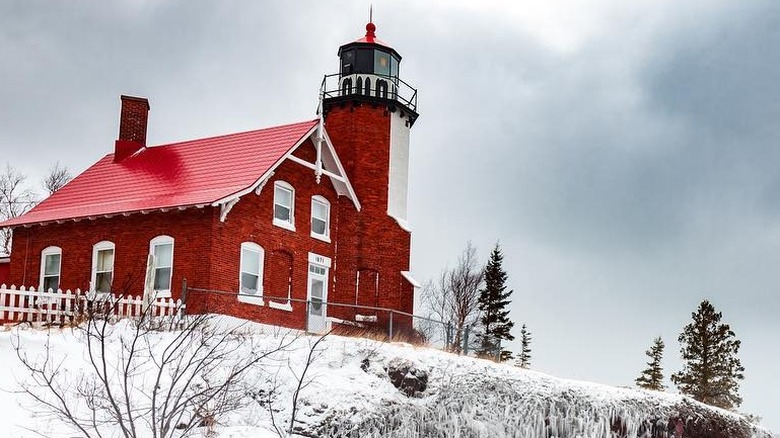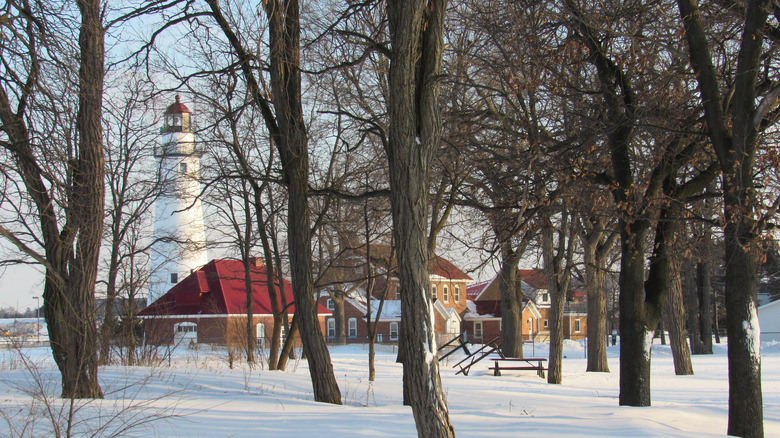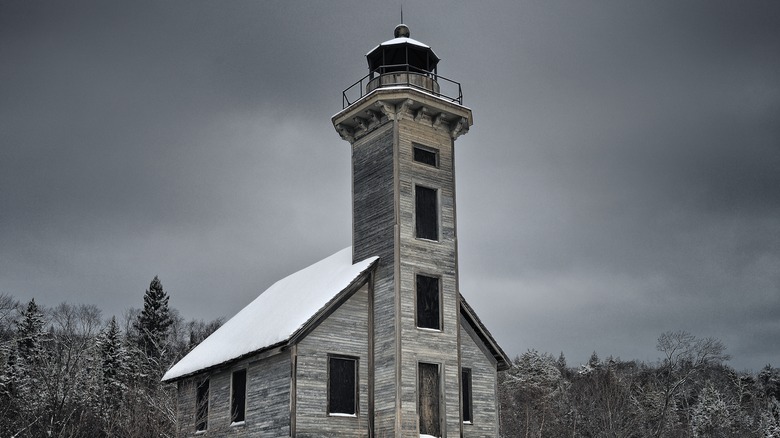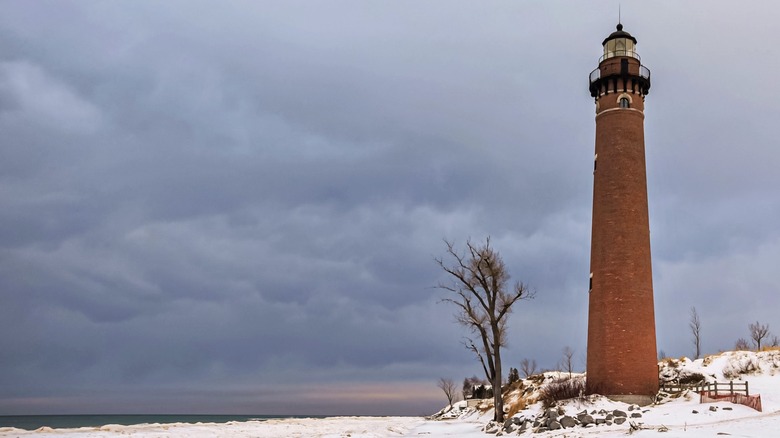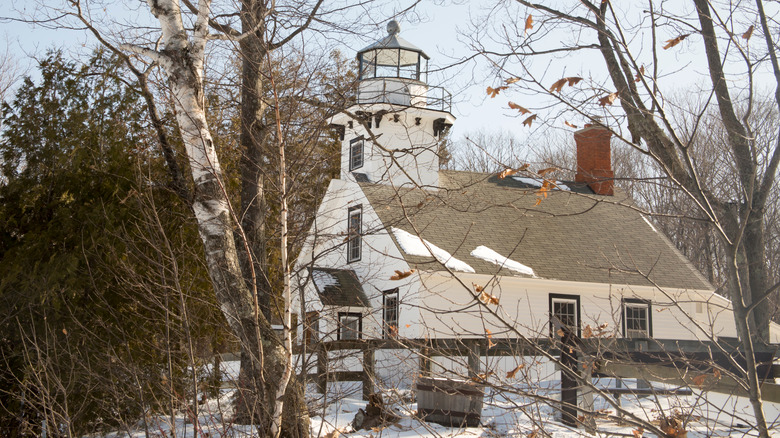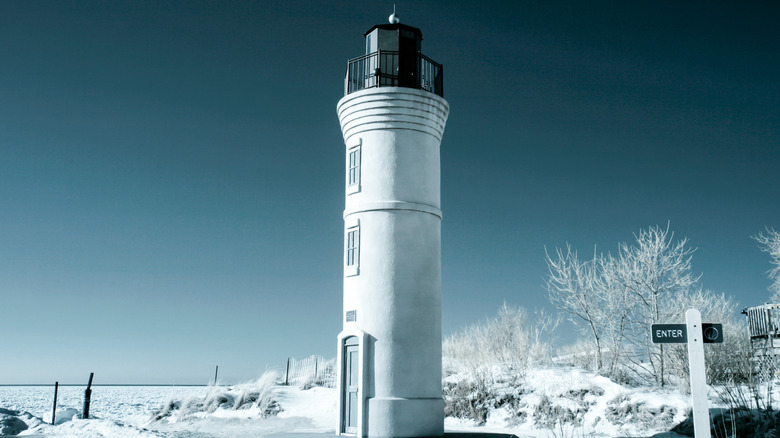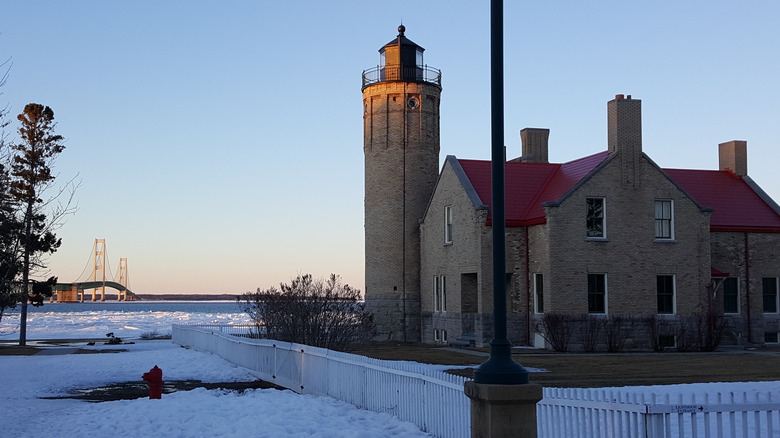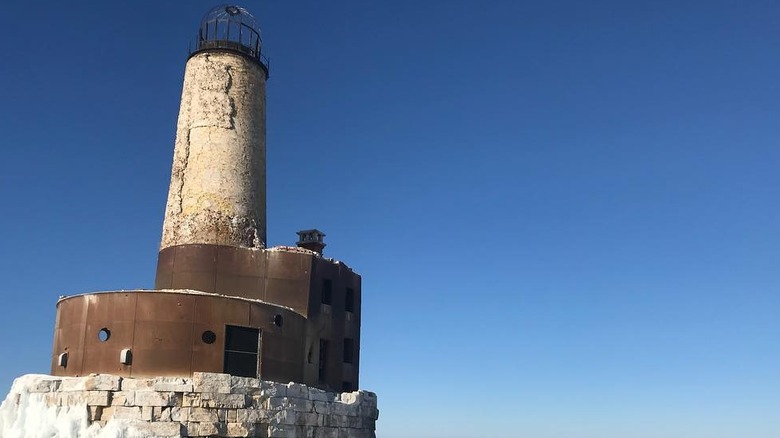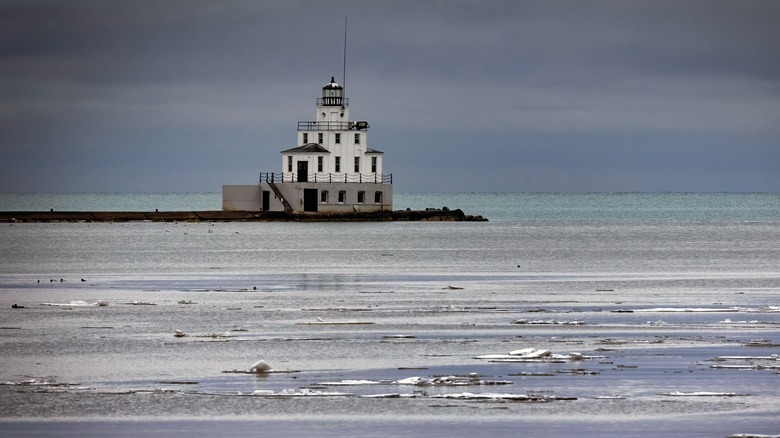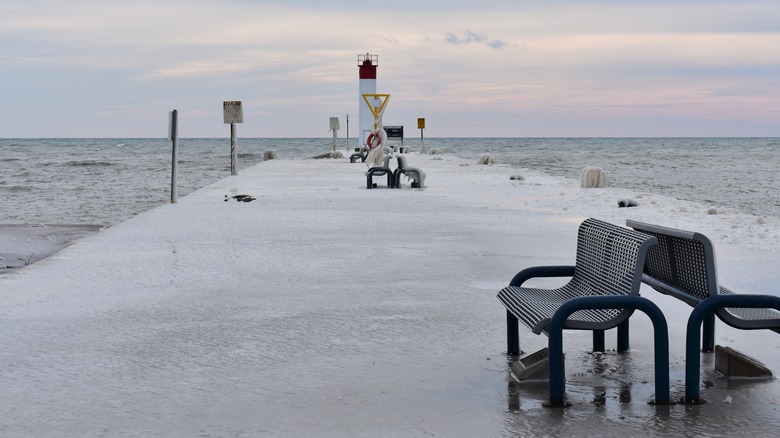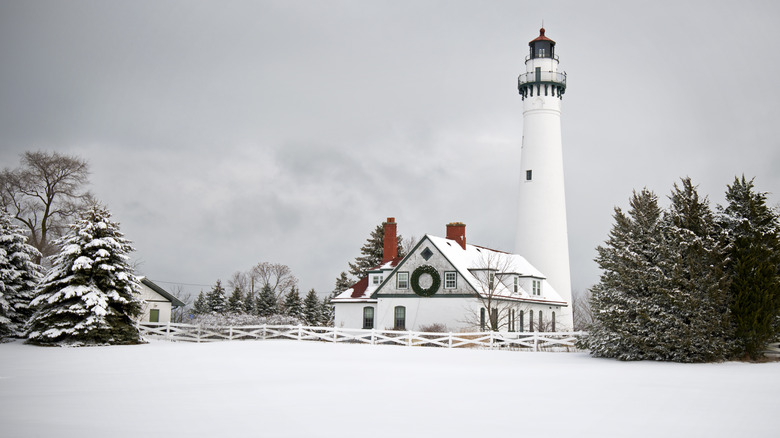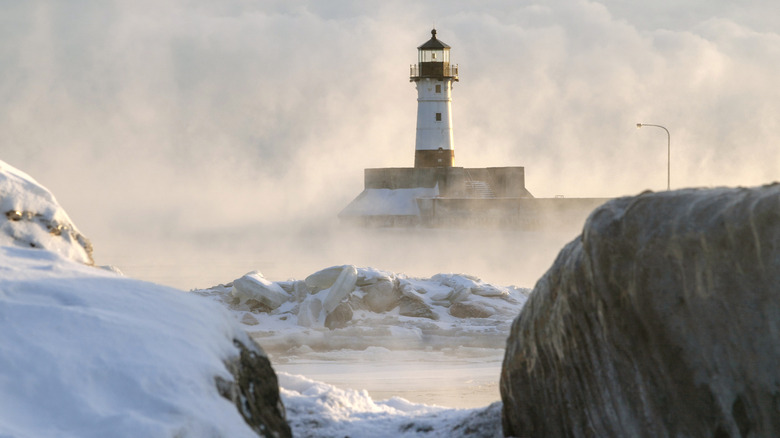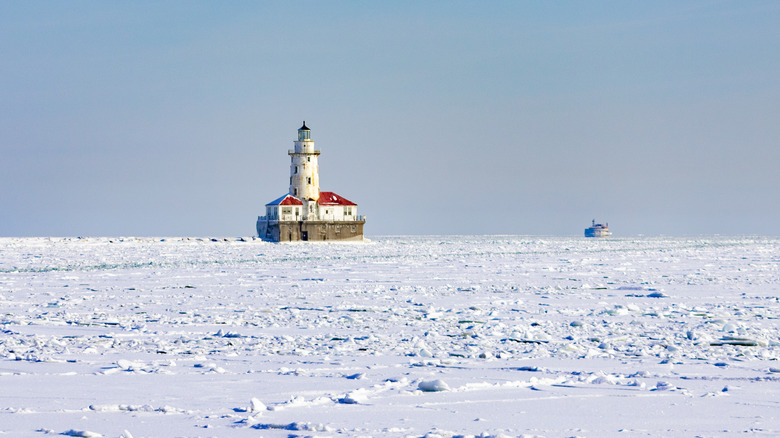Why These Stunning Lighthouses On The Great Lakes Look Best In The Winter
When lighthouses on the Great Lakes freeze over, they look like fantastical ice palaces. While these lighthouses are tourist attractions year-round, nothing compares to how they look when covered in ice and snow, as dramatic sculptures reinforce just how awe-inspiring the Great Lakes can be. Even the ones that don't turn into stunning ice sculptures exude a wintery charm making it worth the trek to take in these guiding lights that have kept sailors safe on the often treacherous Great Lakes.
According to meteorologist T.J. Turnage, a National Weather Service expert who explained the conditions to MLive, several factors come into play to make breathtaking images of frozen lighthouses possible. These include wind speed and direction, wave height, and the temperatures of both the air and the lake. The length of time it has been cold is a contributing factor as well, because if the lake around the lighthouse has been frozen for a long time, the wind won't blow icy water onto the lighthouse.
Cleveland Harbor West Pierhead Lighthouse (Cleveland, Ohio)
The pictures of the Cleveland Harbor West Lighthouse encased in ice wowed viewers around the world in December of 2010 when it was completely covered in a thick coat of ice. Now, in private hands after being sold at auction in 2023, the 1910 lighthouse and its 1916 fog signal house sit at the entrance of Cleveland's harbor after it was added to the National Register of Historic Places in 1983. The brick tower stands four stories high with living quarters on the second, third, and fourth floors. The Fresnel lens was constructed in Paris in 1884 but the lighthouse was electrified in 1931.
Marblehead Lighthouse (Marblehead, Ohio)
Originally known as the Sandusky Bay Lighthouse from 1821 to 1870, when it was renamed the Marblehead Lighthouse, the 55-foot tower was built by William Kelly, Sandusky's first stonemason, with limestone dug out of local quarries. This Lake Erie lighthouse sits on the Rocky Point peninsula and is the oldest continuously operating lighthouse on the Great Lakes.
Its fame has led it to be printed on a U.S. postage stamp and Ohio's license plates. When the U.S. Government made plans to tear it down, locals created the Marblehead Lighthouse Historical Society and were able to save it. The State of Ohio now owns the lighthouse and established what is the second smallest state park in Ohio. In the winter, the white tower stands guard above shoals of ice.
St. Joseph Lighthouse (St. Joseph, Michigan)
Few lighthouses go viral as often as the St. Joseph North Pier Inner and Outer Lights (and the catwalk that leads up to them). When they freeze over, they turn into something out of a fantasy realm, encased fully in ice from the chilly grip of Lake Michigan waters. Located in St. Joseph, Michigan, which is considered one of the best beach towns on the Great Lakes to visit (in part because of the lighthouse), the lights and catwalk were built in 1907, replacing lighthouses from 1837.
In 2013, the City took over the lighthouses from the federal government and turned them into tourist attractions. It is one of only two piers in the Great Lakes (the other being in Grand Haven) that still has its catwalks and range lights. Along with the Marblehead Lighthouse and three others, the St. Joseph Lights were featured on postage stamps issued in 1995 —one lighthouse on each of the five Great Lakes.
Erie Harbor North Pier Lighthouse/Presque Isle North Pier Light (Erie, Pennsylvania)
A black and white sentinel standing guard above snowy drifts and the frozen waters of Lake Erie, the Erie Harbor North Pier Lighthouse (also known as the Presque Isle North Pier Light) marks the entry to Presque Isle Bay, a structure that has been a shining light to safe harbors since 1858.
It was moved to its current location in 1940 and was then encased in steel and painted its current colors. In 2021, the artist Howard Koslow, who had provided the paintings for the 1995 Great Lakes lighthouse stamps, painted the Erie Harbor Light for the Mid-Atlantic Lighthouse postal stamp series. It was one of the last works he created. The lighthouse's design, a square-pyramidal shape, is the only surviving example to be found in the U.S.
Michigan City Lighthouse (Michigan City, Indiana)
With a catwalk that juts out into Lake Michigan, Indiana's only public operating lighthouse is subject to the icy, frigid waves that make it a stunning image during the winter. Since 1904, the lighthouse has been an aid to sailors around Michigan City, Indiana, and its beauty attracts painters and photographers year-round who capture its grandeur.
The current lighthouse replaced one that was built in 1838 and was tended by Harriet Colfax for 43 years. In 2007, the lighthouse, one of Indiana's iconic images, passed hands from the federal government to the city of Michigan City. When the Lake freezes over, ice formations turn the lighthouse and its catwalk into a thing of beauty.
Point Betsie Lighthouse (Frankfort, Michigan)
Sticking out on a bluff in Lake Michigan, the Point Betsie Lighthouse strikes a dramatically beautiful image when surrounded by huge snow drifts and the crashing of frozen waves against its shore. The lighthouse, which was one of three lighthouses that were proposed in 1852 on the Great Lakes, opened in 1858 as a 37-foot tower connected to a two-story Keeper's House.
Designed to help protect ships on the Manitou Passage Underwater Preserve, the tower remains in operation and open to visitors. The red buildings, along with the white tower and black lantern, provide a striking contrast when the area is covered in snow and ice.
Split Rock Lighthouse (Lake County, Minnesota)
Perched high on a rocky bluff, the Split Rock Lighthouse is one of the iconic landmarks of Minnesota. It is Lake Superior's representative in the series of 1995 Great Lakes lighthouses postage stamps. While the lighthouse is too high above the waves to subject it to being encased in ice, winter still makes this lighthouse a breathtaking encounter as snow covers the rock bluffs and the icy trees frame the sentinel as it stands above the powerful waves that crash against the rocks below with all the fury of the winter winds.
Built in 1905 after a winter storm led to 30 shipwrecks, the lighthouse almost immediately became a tourist destination that continues to attract visitors year-round, though the lighthouse proper and historic buildings are closed in the winter. However, the Visitor Center is still open for film viewing and museum tours.
Grand Marais Lighthouse (Grand Marais, Michigan)
With a light that first shone out over Lake Superior in 1895, the Grand Marais Lighthouse stands on the end of a rocky breakwater that becomes surrounded by floating ice on the coldest of winter days. Built in the square pyramidal skeleton style, the light is perched above an iron ladder and was an aid to mariners in what was then being created as a harbor of refuge for shipping.
Today, there are two lighthouses at the entrance of the Grand Marais Harbor at opposite ends of the pier, and both are still operational. Visitors are warned to be careful walking along the pier on days when the waves are high and the ground is icy.
South Haven Lighthouse (South Haven, Michigan)
In South Haven, photographers have captured the effects of Lake Michigan winters on the South Haven Light, a beacon to mariners since 1872. Sitting at the end of a catwalk, the cast iron lighthouse is vulnerable to winds coating it in ice and painting its usual red structure into a fantastical ice sculpture.
In 2012, the lighthouse passed into the hands of the Historical Association of South Haven, which now maintains it while hosting visitors and preserving historical records about the iconic light. Through the years, the lighthouse has been rebuilt and then moved further out into the waters. The lighthouse is one of the reasons that South Haven is considered a great spot for a lakeside vacation, and the draw holds true in the winter as well as for those seeking out a summer beach.
Manistee North Pierhead (Manistee, Michigan)
Where the Manistee River opens up into Lake Michigan, the North Pierhead Lighthouse sends out its welcoming light. First built in 1869, it burned down on the same day as the Great Chicago Fire of 1871 and had to be replaced the following year. Ever a guard against bitter gales and harsh weather, the lighthouse was outfitted with a wooden catwalk to help keepers reach the light during stormy weather.
In the winter, the catwalk becomes hung with intricate ice formations, making the lighthouse a beautiful winter destination. It is now owned by the City of Manistee and the Manistee County Historical Museum and is listed on the National Registry of Historic Places. However, visitors must view the lighthouse either from shore or by boat. Generally, safety concerns keep the catwalk shut off to the public.
Ludington Breakwater (Ludington, Michigan)
At the end of Main Street in the beach town of Ludington, the Ludington Breakwater light has stood on the north breakwater pier since 1924. Still open to the public, the pyramidal, steel lighthouse was designed to deflect Lake Michigan waves, though that doesn't keep it from gathering ice during Michigan's harsh winters.
Meant to protect the car ferries traveling through Ludington Harbor that helped transport people and cars from Michigan to Illinois, the lighthouse is now a popular destination for people who travel there as they can take tours or make climbs hosted by the Sable Points Lighthouse Keepers Association. It has belonged to the City of Ludington since 2006 after the Coast Guard declared it was no longer needed as a navigational aid.
Milwaukee North Point Lighthouse (Milwaukee, Wisconsin)
The Queen Anne-style Keeper's Home and the Milwaukee North Point Lighthouse exude winter charm and classic beauty in an urban Milwaukee environment. One of the oldest structures in the city, it took root there in 1855 with the tower climbing 74 feet tall. In 1984, the lighthouse and Keeper's House were listed on the National Register of Historic Places, and then, in 2003, were turned over to Milwaukee County and leased out to North Point Lighthouse Friends.
It was restored in 2007 and opened for visitors to the Lake Park to tour. The Park around the lighthouse was designed in 1893 by the same person who designed New York's Central Park and the 1892 Chicago Exposition, Frederick Law Olmstead. In the winter, the home is hung with garlands and takes on an almost Norman Rockwellesque look.
Muskegon South Breakwater Light (Muskegon, Michigan)
When the winds blow in, the ice starts to form on Muskegon's South Breakwater Light, also known as Pere Marquette. Normally bright red, winter storms sometimes paint it white with a coating of ice creeping up the structure, which has helped to protect those traveling through the Great Lakes since 1903.
The current 63-foot-tall pyramidal light tower was put into commission in 1931. In 2010, the Michigan Lighthouse Conservancy took over ownership of the landmark, and they are working on renovating both this lighthouse and its sister structure, the South Pierhead Lighthouse, so that they can be reopened to the public. In the meanwhile, winter beckons those who want to photograph the beauty of the ice formations that transform the light after dramatic winter storms.
Grand Haven Lighthouse (Grand Haven, Michigan)
In Grand Haven, two lighthouse structures stand on a Lake Michigan pier. Both are bright red, evoking thoughts of winter candy canes when the ice encroaches on the buildings and they're painted with snowy swathes. It is one of the few locations in Michigan where the catwalk survives, built in part because the snow and ice would bury the pier during the winter months making access to the lighthouse a challenge for its keepers.
Closest to the shore is the 51-foot-tall inner light, while the second, a foghorn house, is pushed further out into the water in a house-like structure. It can be seen and photographed from what is considered one of the best old-school boardwalks in America.
Holland Harbor Light (Holland, Michigan)
In a small town on Michigan's west coast, home to Dutch immigrants who transformed the area into a little bit of home, the Holland Harbor Light, known affectionately as "Big Red," has a history dating back to 1870 when the first lighthouse was built on the site. Since 1978, the Holland Harbor Lighthouse Historical Commission has owned and maintained the lighthouse.
The Lighthouse Commission recommends that visitors take in the view from Holland State Park's boardwalk or the top of the dune staircase at Mt. Pisgah. In the winter, the red structure provides a stark contrast to the snow and ice that surround it. One photographer described the winter landscape as unforgiving, saying, "Waves crashing into the shore sprayed water and ice high into the air. The bright red color of the lighthouse is striking against the frozen scene on Lake Michigan."
Marquette Harbor Lighthouse (Marquette, Michigan)
Standing proud on a rocky bluff, the red Marquette Harbor Lighthouse has withstood the unforgiving winters of Michigan's Upper Peninsula and the waters of Lake Superior. The first one on the location was built in 1853, it had to be rebuilt several times. Through the years, the lighthouse was renovated with various additions that made it unique on the Great Lakes in its design, which is part of what landed it on the National Register of Historic Places.
When snow covers the hillside leading up to the lighthouse, it takes on a dramatic appearance making it an impressive winter sight. And once you've made the trip to see the icy lighthouse, stay the night, as winter is a great time to catch the Northern Lights, and Marquette is one of the best places in the U.S. to see them.
Eagle Harbor Light (Keweenaw County, Michigan)
In Michigan's Upper Peninsula, a charming structure of Christmas-y red protected shipping in Keweenaw County. The Eagle Harbor Light is housed in a brick structure on Lake Superior with a light that the U.S. Coast Guard still operates. Originally built in 1851, it now houses four museums.
While the Keweenaw County Historical Society has owned the lighthouse since 1999, the top of the tower is closed to visitors because it's still used as a navigational aid. Winter visitors will be able to see the contrasting red building standing out against the ice formations hanging from the shore as Lake Superior's waves batten the bluff.
Fort Gratiot Light (Port Huron, Michigan)
Viewed through barren trees and snow-covered grounds, Michigan's oldest lighthouse provides a pretty picture of Port Huron, Michigan. Fort Gratiot Light, the second oldest on the Great Lakes, was built in 1829 by Lucius Lyon, one of Michigan's first U.S. senators.
Standing 82 feet tall, the lighthouse is still in operation, and visitors are occasionally allowed to climb the tower, where they can see the Blue Water Bridge or traverse the catwalk. Providing support to ships passing through Lake Huron to the St. Clair River, the waterway continues to host busy shipping traffic. Group tours are available year-round, but the lighthouse is closed to individual visitors during the winter.
East Channel Light (Grand Island, Michigan)
Now a privately owned structure near Michigan's Pictured Rocks, the East Channel Light is a singular building that almost evokes the feel of an old-country church rising above the snowy pines and trees of its surroundings. Boat tours still give tourists and photographers a chance to see the historic structure while others fly above it in private planes to capture photos of the building in its snow- and ice-covered glory.
Sitting on Grand Island, the lighthouse first went into service in 1868, though storms and erosion forced it to be moved in 1898. In more recent years, private citizens have worked on restoring the structure that had begun to crumble and was threatened by erosion.
Little Sable Lighthouse (Mears, Michigan)
With a very traditional, cylindrical appearance, the Little Sable Lighthouse's red, sand-blasted brick structure guards a beach near the silvery dunes of Mears, Michigan. Built in the 1870s, it continues to be open for tours from May to September, but during the colder months, it attracts photographers who help share its winter glory when cloudy skies provide a dramatic backdrop to the sentinel rising from snowy ground. It stands 100 feet tall and is leased by the Sable Points Lighthouse Keepers Association to keep it open to the public.
Old Mission Lighthouse (Traverse City, Michigan)
Built in 1870 in what is now the heart of Michigan, the Old Mission Lighthouse is a 36-foot tall beacon that rises out of the front of a one-and-a-half-story keeper's house. Situated on a bluff to help extend the reach of its light, the classic architecture makes it a lovely site when the snow covers the hill and dresses the structure with icy accents.
While the Traverse City lighthouse is closed for tours during the winter, the park stays open daily until 10 p.m., and photographers visit to capture the lighthouse in its seasonal glory. Traverse City is one of the best wine destinations in the U.S., and winter is a great time to check out their ice wines.
Manning Memorial (Empire, Michigan)
More of an Instagram invitation than a navigational aid, the Robert H. Manning Memorial Lighthouse is fairly young as far as these structures go. The tiny lighthouse was built in honor of an Empire resident who loved to go fishing in Lake Michigan and, throughout his life, advocated for a lighthouse to help those boating back to town. After he died, his friends and family built the lighthouse that became a favorite for photographers. In the winter, the white building blends in with the ice-covered trees and the beach, whose sand hides under the piles of snow.
Old Mackinac Point Lighthouse (Mackinaw City, Michigan)
One of the prettiest lighthouses in Michigan with a view of the renowned Mackinac Bridge (the longest suspension bridge in the Western Hemisphere and one of the most amazing bridges in the world) connecting Michigan's upper and lower peninsulas, the Old Mackinac Point Lighthouse sits on the shores of Mackinaw City.
Surrounded by a white picket fence, the lighthouse and nearby structures serve as a museum from spring to fall, with costumed interpreters taking people back in time to 1889 when the lighthouse was built. While it isn't possible to climb the lighthouse in the winter, the complex still provides charming views that evoke a bygone era and make this a winter wonderland.
Waugoshance Lighthouse (Mackinac Island, Michigan)
After many efforts to restore the Waugoshance Lighthouse, experts have determined that there is nothing left that can keep it from sinking into the depths of Lake Michigan. An off-shore lighthouse, it is visible by ferry or, during the winter, by snowmobilers brave enough to travel across the frozen lake. Opened in 1851, it's about 15 miles west of Mackinac Island and visible from its shores.
When the Lake freezes, the bleak winter accents the haunting ruins that are all that remain of this once-proud navigational aid. The lighthouse is rich in history having been around since before the Civil War, and once was used for bombing practice during WWII. It shows up on lists of haunted lighthouses claiming that a drunken keeper who went missing continues to perform mischief at the structure.
Stannard Rock Light (Marquette, Michigan)
In 1922, the U.S. Coast Guard photographed Stannard Rock Light encased in an iceberg. The Marquette, Michigan Light has earned the nickname of the Loneliest Light on the planet, and in the winter, it becomes encased in a fearsome stretch of ice, accessible only by air. Built on a submerged reef in Lake Superior, it acts as a weather and climate research facility. Built in 1882, it was needed because of how hazardous navigation was through that portion of the lake.
It's 24 miles to the nearest land, and the crib on which it was built is hailed as one of the top ten engineering feats in the U.S. Reaching 110 feet tall, it took five years to build because of the harsh weather, but now is an important winter site because it's one of the few places from which climate data can be collected during frozen months when other buoys have been removed from the waters.
Manitowoc Breakwater (Manitowoc, Wisconsin)
Jutting out into Lake Michigan Bay in Manitowoc, the Manitowoc Breakwater first rose from the shore in 1895 before getting rebuilt in 1918 and then automated in 1971. In 2010, the lighthouse was sold at auction to Philip Carlucci, who had been involved in several lighthouse restoration projects in New York.
He restored the lighthouse in time for its 100th birthday, and it is occasionally open to group and educational tours. During winter months, the impressive 40-foot tall structure is often surrounded by floating ice, a symbol of strength and fortitude in the oft-dangerous waters, a symbol that attracts photographers and artists alike.
Rockwell Lighthouse (Oshkosh, Wisconsin)
Not all lighthouses were built by the government. Rockwell Lighthouse, also known as Bray's Point, was the dreamchild of lumber baron William Bray, who enjoyed yachting and sailing near Oshkosh, Wisconsin. Determined that the harbor needed a lighthouse, he hired George A. Rockwell to design the lighthouse.
While Rockwell died before he could build it, Bray went forward with the construction of the concrete, octagonal, 26-foot-tall lighthouse. Restored in 1980, it still sits on private land. Filled with a quaint allure, the snow-covered lighthouse is the subject of many a winter photo, though photographers do advise that one should always seek permission before walking through the area to take pictures.
Whitby Lighthouse (Toronto, Canada)
Known for its wild winters, Canada's Whitby Township is home to a Lake Ontario lighthouse. Whitby Lighthouse was first built in 1844 and then replaced with a larger, octagonal lighthouse in 1857, a wooden structure designed by the harbormaster at the time.
That structure was moved to a farm in 1958 and replaced with the current 25-foot tall tower, which, as of 2021, continued to flash lights out into the harbor. Sitting at the end of a long, concrete pier, the light takes on a singular beauty during winter months against the vast expanse of the Lake and the stormy clouds.
Wind Point Lighthouse (Racine, Wisconsin)
When it's beginning to look a lot like winter, the Wind Point Lighthouse in Racine, Wisconsin exudes a rural loveliness that draws those seeking romantic views of Midwest winters. Surrounded by a white fence, the snow drapes itself over the red roof and the 110-foot tower points to the sky, topped off by a 10-sided lantern room.
The brick structure was the second lighthouse on the Great Lakes to be electrified in 1923 and then was placed on the National Register of Historic Places in 1984. In 1997, the Village of Wind Point was given ownership of the lighthouse, and it provides tours of the historic site.
Duluth Harbor North Pier Lighthouse (Duluth, Minnesota)
When the winds blow across the waters in Lake Superior, Duluth Harbor's North Pier Lighthouse is sometimes shrouded in icy air, making it a stunning sight for tourists willing to brave the cold and witness the unforgettable images the weather and structure create. Put in operation in 1910, the 36-foot tall lighthouse is made of steel and cast iron and guards the Duluth Ship Canal on a 1,720-foot-long concrete breakwater. The lighthouse was turned over to a St. Paul-based nonprofit in 2023 with plans for tours to begin in the summer of 2024. Duluth is home to what has been called the most criminally underrated beach in the Midwest.
Chicago Harbor Lighthouse (Chicago, Illinois)
Marking the entrance of the Chicago Harbor from Lake Michigan, the 1893 Chicago Harbor Lighthouse, built for the World's Columbian Exposition, is the city's only surviving lighthouse. Just east of Navy Pier, the lighthouse was transferred to the City of Chicago in 2009 after being designated a Chicago Landmark in 2003.
Viewed from either the pier or the Chicago beach, the lighthouse takes on an ethereal and lonely beauty in the winter when the Lake freezes over and drifts of snow make the structure stand out from the tundra. Given that the city is already considered one of the top winter destinations in the world, adding this lighthouse to the itinerary makes perfect sense. In 2023, a nonprofit announced restoration efforts aimed at turning the lighthouse into a museum accessible from Navy Pier.
